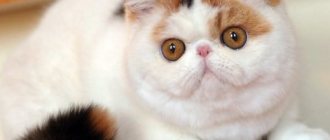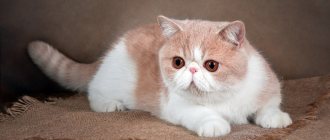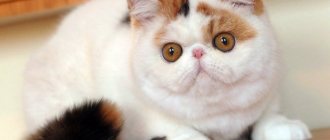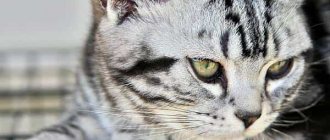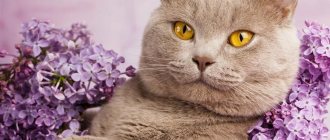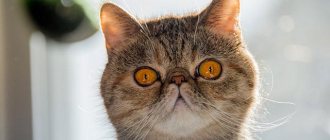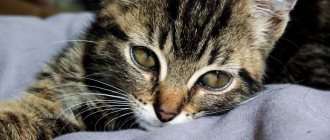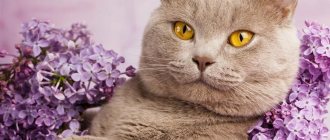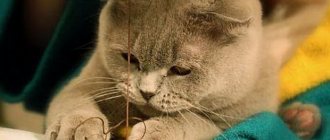Exotic Shorthairs are compact, attractive cats with plush fur, a flattened nose and huge, expressive eyes. Thanks to their charming appearance and friendly disposition, they are the object of dreams for adults and little animal lovers. But in order for communication with an exotic to bring only joy, before buying an exotic, you should study the main characteristics of the breed.
Brief history of the breed
The exotic shorthair cat, or exotic, appeared in the 50s of the last century. The main task of the breeders was not to develop a new variety, but to expand the color palette of the existing Persian cat breed. Therefore, we can assume that it arose completely by accident. To get other colors and make the American Shorthair's bones a little heavier, breeders decided to cross them with Persians. The kittens born from this mating were not at all similar to the original breed. The kids were almost an exact copy of their eastern ancestors. Although the Persians did not give them the luxurious long fur coat, they all had characteristic upturned noses and flattened muzzles.
In 1966, Jane Martink made a proposal to distinguish a new variety into an independent breed and call it “Exotic Shorthair”. This caused a wave of indignation among Persian breeders. But among them there were also those who showed interest in the new breed line of animals, and work on improving exotic animals continued. To fix the shorthair gene, breeders used Burmese and Russian blue cats. But as soon as the result was achieved, mating of exotics with anyone other than Persians was immediately prohibited.
Cost of an exotic kitten
The average price for one exotic kitten as a pet is 50 thousand rubles. If the pet has a breeding defect - shortcomings that preclude its use for breeding, the cost is reduced several times.
Animals for breeding and show class are much more expensive than pet class pets.
It is not recommended to purchase kittens secondhand via the Internet or through an advertisement for sale. A reliable option is to buy exotics from a nursery.
Photo gallery of the exotic breed:
1111
Interesting Facts
During the existence of the exotic cat, many interesting things have been associated with this breed:
- Due to their short fur, which does not require special care, these animals are jokingly nicknamed “Persians for lazy people.”
- Thanks to their doll-like appearance and wonderful character, exotics often make it into the top ten most popular breeds.
- At first, they wanted to call snub-nosed cats “sterling,” which translated from English means “high-quality silver.” But after much thought and discussion, they began to be called exotic shorthairs.
- In addition to the exotics, there is another variety similar to the Persians - extreme. These cats have flattened noses that are noticeably pressed into the skull.
Reviews about exotic cats
Owners speak of their pets as exceptionally gentle and good-natured creatures. According to them, these animals are very quiet, moderately playful, inquisitive and friendly. They will never rush at a person or offend him. Cats are clean and do not smell. Pets show interest in everything new - they strive to touch unfamiliar objects with their paws and smell them. Reviews about the breed are only positive.
Those who want to get an exotic cat need to be prepared to give it a lot of attention. If the work involves business trips, it is better to choose another breed, since exotics have a hard time withstanding separation from a person.
Breed description, standards, appearance
An exotic cat is a well-balanced animal with strong, somewhat heavy bones. The breed standard fully duplicates the requirements for Persians, with the exception of the clause on the length and structure of the coat.
Dimensions and weight
Representatives of the breed are not overly large in size. An adult exotic cat weighs up to 7 kg. The weight of a cat usually does not exceed 5 kg.
Anatomical characteristics
A typical Exotic Shorthair should fit the following description:
- The head is round, massive with a developed chin, full cheeks and wide strong jaws. The nose is short and upturned. The main feature of exotics is the stop placed strictly between the eyes.
- The ears are small, set wide apart, with rounded tips, slightly tilted forward.
- The eyes are expressive, convex, round. Located far from each other. The eye color is in harmony with the shade of the coat. Color-point exotics can only have blue irises.
- The body is without signs of obesity, squat, with developed muscles, massive shoulders and a broad chest.
- The limbs are short, thick, strong, with large rounded paws.
- The tail is carried below the level of the back, straight, without bends, and proportional to the length of the body.
Color and coat type
The body of the exotic is covered with a soft, silky, tight-fitting awn, the length of which does not exceed 2 cm. Under it there is a thick undercoat that can provide reliable protection from the cold.
The breed standard allows for the existence of many colors with the exception of light beige and cinnamon. The most common species are tortoiseshell, bicolor and tricolor. But solid colors of exotic cats, such as black or blue (gray), are considered rare.
On a note. White exotics can have different colored eyes. Heterochromia is also acceptable in individuals with Van, Harlequin and Bicolor colors.
Possible breed defects
Flaws in appearance, in the presence of which the exotic will not receive a high expert assessment:
- weak hind limbs;
- polydactyly;
- strabismus;
- asymmetry of the head or muzzle;
- creases on the tail;
- spinal deformity.
Health and disease of the exotic shorthair cat
Black Exotic
Exotic Shorthair is an artificially bred breed, which in essence is no different from its relatives - the Persians (except for the length and structure of the coat). It is absolutely logical that the genetic diseases in these two breeds are almost identical.
The most common diseases of the respiratory system and eyes occur in exotic animals. The reason is obvious - the unusual structure of the muzzle and the associated deformation of the nasolacrimal duct.
A genetic predisposition to kidney disease and cardiomyopathy is clearly visible. The latter disease very often causes the death of animals of this breed at an early age.
The oral cavity of the exotic can also be considered a risk zone, and a fairly high one at that. Without proper care of your gums and teeth, gingivitis, periodontal disease and other inflammatory diseases may occur. Sometimes cats have abnormally developed lower jaws, which can lead to problems eating.
The best prevention of the occurrence or complex course of these and other diseases is proper care and careful monitoring of your pet’s condition. Timely vaccination, deworming, preventive examinations at a veterinary clinic - all these simple measures will help you avoid unnecessary problems and maintain the health of your exotic shorthair cat for many years.
Character and temperament
Representatives of the short-haired exotic cat breed are distinguished by their friendly, flexible and calm disposition. They feel the master’s mood very subtly and will never impose their company at the most inopportune moment. Exotic Shorthairs quickly become attached to people and need attention. These cats do not tolerate prolonged loneliness well. Due to their natural curiosity, they often lose their sense of danger. Therefore, exotic animals should not be left unattended for a long time.
The amiable nature of the exotic cat allows her to easily find a common language with children. She almost never shows aggression, and you have to try hard to unbalance her.
The exotic cat gets along without problems with his brothers and friendly dogs. But there may be problems with small rodents, ornamental birds and fish, since representatives of the short-haired exotic breed still have a hunting instinct.
Psychology
Exotics have a calm disposition, although young individuals occasionally run “races” around the house, flexing their powerful muscles.
In addition, Snoopy is silent; they rarely give voice, only when they really need something.
Exotics are selective in their affections and at first look closely at their owner.
However, if you manage to find a rapport with the plush charm, you will receive almost dog-like affection.
An exotic cat needs communication and becomes attached to a specific person.
You can read about other sociable cat breeds here:
This may cause some inconvenience if you need to leave your pet - exotic cats, unlike Scottish Straights or Scottish Folds , feel sad when separated.
But they can handle any type of transport well and travel willingly.
If you already have other pets - cats or dogs - in your house, the conflict-free Snoopy will become an excellent companion cat for them.
Yes, yes, the exotic cat can read. You can discuss a book you recently read with him. True, he will keep his opinion to himself
How to choose the right kitten
Since this is a fairly popular cat breed, buying an exotic cat will not be difficult. The main thing is not to purchase an animal from someone else, but to look for a trusted breeder or a specialized nursery.
At the time of sale, exotic kittens must have documents confirming their breed and vaccinations. The first impression of an animal's character can be formed by observing how it behaves in its usual environment. And the health status of a potential pet is judged by its appearance. An exotic shorthair kitten should have clear eyes, clean ears, soft fur without bald spots and smooth skin without scratching or rashes.
On a note. A kitten's bloated belly may indicate a helminthic infestation. And dirt under the tail and stench from the mouth are signs of digestive problems.
Kitten care
Responsible breeders wean exotic shorthair kittens from their mothers and hand them over to new owners no earlier than they are 3 months old. By this age, the animal already has the necessary vaccinations, eats independently, goes to the tray and knows how to use a scratching post. The owner just has to show the kitten where he can eat, recover and sharpen his claws.
In order for adaptation to changed conditions to happen faster and without problems, the exotic is given time to get acquainted with his new possessions. He is petted more often and involved in various games.
To prevent a curious exotic kitten from becoming a victim of an accident, houseplants, household chemicals, wires, small and fragile objects are removed from it. Also, for safety reasons, close the doors of ovens, washing machines and dryers.
Buy an exotic kitten
To find out how much an exotic cat kitten will cost, you should understand what its price consists of:
- appearance, compliance with the description according to the standard;
- “purity of blood” - kittens from parents with the title of champions are many times more expensive;
- rarity and beauty of color;
- care activities carried out by the breeder, including medical examination, sterilization, castration and vaccination;
- seller: elite nurseries with a good reputation guarantee the purity of the breed, but kittens sold on Avito, Yula and other free trade sites may cost less. Please be aware that such a purchase does not come with any guarantees.
Thus, the absence of a pedigree reduces the cost of a cat - it is quite possible to buy a supposedly exotic cat, and when its fur, cut by an unscrupulous seller, grows back, it turns out that it is an ordinary Persian cat.
buy exotic at a price of 15,000-50,000
rubles
Nicknames for exotic cats
The purchase of a kitten immediately forces the owners to start coming up with a suitable and beautiful nickname for it. To choose the right name for your fluffy bundle of joy, there is no need to rush.
global $ads_google; //data-ad-slot=”2475549904″ $ads_google = empty($ads_google) ? false : true; ?> if ($ads_google == false) {?> $ads_google = true; ?> } ?>
Cats get used to a good nickname quickly and react well to it. It is believed that a meowing friend only hears the first three sounds in his name. If you are guided by such information, then you should choose nicknames where the first part of the name will set the tone. Otherwise, the cat will respond better to “kitty-kitty” than to the name given by the owners.
The character and color of the young big-eyed purr also plays an important role in such an important matter.
To decide what to name an exotic boy or girl, you should first familiarize yourself with the best names.
| Girl | Boy | ||
| Laura Barbie Paprika Redhead Gemera Justina Rada Vita Yalta Desi Helly Frosya Varya Ruby Bella | Musya Tracy Businka Ulana Krosha Anta Lapka Claire Frida Chucha Korni Leila Irma Diana Fufa | Kuzya Renault Wolf Raisin Cam Nils Jazz Coconut Chubais Jaco Emir Lace Azar Vermouth Mot | Draco Velez Joy Simon Austin Bolt Maurice Pie Pirate Gosha Snowball Noir Tom Pepper Fay |
Care and maintenance
Exotic shorthairs adapt well to different conditions. Cats of this breed live without problems in both small apartments and spacious country houses. The main thing is that they have their own corner to relax. It is better to arrange it closer to the owners so that the exotics feel protected.
Hygiene procedures
In order for the cat to look neat, he is provided with complete care:
- Exotic ears are cleaned weekly of accumulated dust and dirt. To do this, a special agent is instilled into each of them. After a few minutes, the exotic’s ears are carefully wiped with a cotton pad or clean cloth.
- The cat's eyes are examined daily for unusual discharge. If necessary, wipe them gently with a moistened cotton pad.
- The exotic shorthair's teeth are cleaned 2-3 times a month with a non-foaming paste and a silicone brush or a special attachment. This simple procedure will prevent the formation of plaque and stone.
- Exotic claws are shortened with a nail clipper as necessary. This is done very carefully so as not to injure living tissues and not cause pain to the cat.
Grooming
Exotics are short-haired animals that do not require such professional coat care as their closest relative, the Persian cat. To make them look attractive, it is enough to comb their fur twice a week with a special metal comb.
On a note. The smooth-haired exotic is a very clean cat. He often licks his thick coat, clogging his digestive tract with lint. Therefore, it is recommended to periodically give him special pastes that dissolve wool.
Exotics are bathed no more than 3-4 times a year. Bath procedures are carried out in a warm room, away from drafts. The exotic shorthair is lathered with a special shampoo and thoroughly rinsed with clean water. The bathed cat is dried with a towel and, if necessary, dried with a hairdryer.
Tray
The Exotic Shorthair is a rather large cat. Therefore, the tray for her is chosen to be quite spacious and deep. It is installed in a secluded corner, where no one will disturb the exotic creature’s privacy. The filler can be anything - wood, silicate, etc. The main thing is that it is of high quality and that the cat likes it.
Castration and sterilization
If the cat is not intended for breeding, it is better to spay or sterilize the animal. During castration, the reproductive organs are removed, in whole or in part. A cat's testicles are removed; in a cat with partial castration, only the ovaries; in a complete castration, the uterus is removed. However, recently, partial castration has been offered less and less due to the risk of developing pathologies in the uterus that began before castration. During sterilization, nothing is removed, but the spermatic cords of the cat or the ducts of the cat are ligated.
In this case, the animals retain the ability to mate without producing offspring. Typically, sterilization is practiced in nurseries.
This procedure is sometimes necessary for professional felinologists and owners of purebred catteries in their breeding work. Cats are capable of giving birth several times a year, and male cats are capable of demanding and mating cats with virtually no breaks. Therefore, to solve such problems, sometimes a sterilized cat is kept in the cat group. But owners of ordinary domestic cats and male cats do not need sterilization, and their pets need to be castrated.
Maria Epifanova
Magazine "FRIEND" No. 06(08) June 2004
Experienced veterinarians and breeders recommend castrating exotic cats at the age of 7–9 months.
Caring for your pet after surgery
Caring for a cat or an exotic breed is no different from caring for animals of other breeds. On the first day after surgery, it is necessary to monitor the pet’s condition, provide it with warmth, peace and absence of contact with other animals, if any.
The animal after surgery requires special attention
During the postoperative period, the animal experiences:
- Dry eyes. When anesthesia is administered, cats' eyes do not close; they remain open. During the operation, the veterinarian closes the animal's eyelids from time to time so that the conjunctiva is moistened with tears. Until the cat recovers from anesthesia, the owner will have to do this. In order to properly care for your pet's eyes, you need to buy tetracycline eye ointment or antiseptic drops. After the pet has recovered from anesthesia, there is no need to close his eyes; he will do this on his own. There are times when an animal lies for a long time with its eyes open, then it is necessary to drip saline solution into the eyes, this will save them from dryness.
- Low body temperature. The usual cat temperature is 37.5 – 39.0 degrees Celsius. In the postoperative period, the temperature can drop to 36.5 - 37.0 degrees. The cat should be placed on a warm bedding and covered with a warm blanket. In extreme cases, you can warm it with a heating pad. To normalize blood circulation, you need to rub the ears and paws.
- Unsteady gait. This is due to the relaxation of muscles during the application of anesthesia. On the first day, you should better monitor your pet so that he does not climb to any height, otherwise he may not be able to hold on and fall.
- At first, the cat needs painkillers. If your pet is silent, this does not mean that he does not feel pain. Most animals silently endure pain. They completely refuse food and are in a motionless position. Their pupils, as a rule, are dilated and concentrated. The gaze is fixed on one point.
The owner's actions in the postoperative period:
- Every day it is necessary to examine the groin area and check for bleeding;
- In order for the sutures to heal better, they are treated with hydrogen peroxide and brilliant green twice a day; you can also lubricate the suture area with Levomekol ointment;
- During the rehabilitation period, the cat must be wearing a collar that will prevent the animal from licking the wound, as this can lead to the sutures coming apart and, accordingly, infection;
- The rehabilitation period is easier in the winter; if the operation was performed in the summer, then a five-day course of antibiotic therapy may be needed - it is better to be on the safe side than to treat the resulting infection later.
Feeding the cat
In order for the exotic to grow well and develop properly, it is provided with a balanced diet.
Complete diet
Exotic shorthairs are unpretentious animals with an excellent appetite. They eat both industrial and natural food with equal pleasure. At home, it is easier and easier to feed a cat of this breed with premium or super premium class dry food, which already contains all the necessary substances. These requirements are best met by the British Arden Grange, the American Pro Pac, the Italian Monge and the German Bosch.
With a natural type of nutrition, the diet of an exotic shorthair is designed so that it contains at least 70-80% meat. The cat is also given:
- boiled eggs;
- porridge with water;
- offal;
- boiled vegetables;
- dairy products;
- lean sea fish.
An exotic shorthair cat should not be given pork, onions, potatoes, whole milk, sweets, sausage, baked goods or smoked foods. Representatives of the breed are prohibited from feeding pickles, river fish and any leftovers from the master's table.
Feeding frequency
An exotic kitten eats less, but more often than an adult representative of the breed. Therefore, the number of feedings depends solely on the age of the animal:
- up to 12 weeks – 5-6 times a day;
- 4-7 months – 4 times a day;
- 8-11 months – 3 times a day.
From the age of one year, the exotic shorthair cat is fed twice a day.
Vitamins and minerals
When feeding natural products, not all necessary substances enter the body of an exotic shorthair. To compensate for the deficiency of vitamins and microelements, the cat is given special supplements in courses twice a year. Feeding should be selected by a veterinarian, taking into account the individual characteristics of a particular animal.
Features and behavior
A feature of exotics is their activity and curiosity. In this they are very different from the Persians. In addition, breeders are convinced that representatives of the breed are quite intelligent and playful. They especially love having fun with people.
You can always find a common language with a cat; she will not be aggressive towards children or other pets.
Character
The main character traits of the cutest pet include:
- high level of intelligence;
- quick learner;
- sociability;
- affectionateness;
- peacefulness.
Owners of exotic cats are convinced that cats suppress unpleasant emotions and always try to remain in a calm state, without expressing aggression. In most cases, pets get along well with all family members and enjoy playing with children. The playfulness of an animal, as a rule, does not go away until old age. Cats are ready to have fun day and night. It is extremely rare to hear meowing in the house.
Despite the fact that the cat’s appearance is pretty, he can perfectly stand up for himself if the situation requires it. In addition, exotic animals living in the private sector can catch rodents, which they really do not eat in most cases but bring to the owner , as if boasting of their hunting qualities.
The pet's intelligence is manifested in recognizing people's moods. If a person internally treats an animal with disdain, he will not even be in the same room with it. As for the relationship with the owner, in this situation the exotic cat shows true canine fidelity.
She will become a devoted companion who will always be there. She even rests near a person without feeling the need for privacy. If the owner is sick, then cats become home healers and lie down on sore spots, trying to heal the patient.
The fluffy plush pet loves to look at a person, which emphasizes its uniqueness. In addition, they often sniff their family members and cuddle with their paws when they are sad and want to be cuddled.
No matter how many people there are in the family, the cat chooses only one owner, who tries to devote the greatest amount of time to him and gives him food . When choosing, it is worth considering that cats become more attached to humans than cats. Therefore, it is better for people who are busy at work to choose the latter.
Education and physical activity
Exotic Shorthairs are intelligent cats that are receptive to training. They easily get accustomed to the tray and scratching post and easily learn basic commands. In the process of raising an exotic, force and threats should not be used. If a cat is intimidated and physically punished, there is a risk of losing its trust forever.
Exotic shorthairs have a fairly active temperament. Active and playful cats will not refuse to run after a ball or a laser pointer. And so that exotics don’t get bored when their owners are away, you can buy them several toys and arrange a corner with multi-level shelves.
Breeding Features
Breeding exotic cats has its own nuances. The fact is that only 50–75% of kittens are born with short hair, the rest have long hair. Most felinological organizations, except for the CFA and GCCF, classify kittens with long hair born from exotic cats as the Persian breed.
Longhair exotic
Animals belonging to the show and breeding classes are used for breeding. Puberty in cats occurs at 8 months. Females who have already had several heats are allowed to crossbreed. It is customary to arrange a date for a couple on the territory of the gentleman. Cats do not immediately allow the groom to approach them; they need time to get comfortable and get to know their chosen one. Mating is considered successful if, 4 weeks after it, the female does not begin another estrus.
Vaccinations and antiparasitic treatment
To prevent possible infection with infectious and viral diseases, exotic shorthairs are regularly vaccinated. The complex drug stimulates the production of immunity:
- to calcivirus;
- rhinotracheitis;
- panleukopenia.
The first vaccination for an exotic shorthair is given at the age of 7-8 weeks. After 4 weeks, the cat is vaccinated against the same diseases and against rabies. Subsequently, the exotic is vaccinated annually.
To protect a cat of this breed from diseases carried by fleas and worms, it is periodically subjected to antiparasitic treatment. Anthelmintic drugs for exotic shorthairs are given 2 times a year with mandatory repetition after 10-14 days.
A cat of this breed is protected from fleas using special drops and shampoos. And if an exotic shorthair is outdoors, an anti-parasitic collar is additionally put on it.
Exotic health, life expectancy
The lifespan of any cat, including exotics, depends not only on genetic predisposition, but also on the animal’s nutrition and living conditions. On average, representatives of the exotic breed live 15 years, but in the absence of genetic diseases and ideal maintenance they can live longer (up to 20 years).
With proper nutrition and care, exotics can live more than 15 years
Most of the diseases that plush pets are prone to were transmitted to them from the Persians. Thus, exotics may suffer from the following diseases:
- Polycystic kidney disease. Signs of polycystic disease appear already in an adult animal (age 3–10 years). It is impossible to get rid of this problem, but with timely treatment, you can improve your pet’s well-being and slow down the development of the disease. Improvements can be achieved with the help of special therapy and nutritional adjustments. A cat that has this disease begins to lose weight and exhibits disturbances in the functioning of the digestive system (vomiting, loss of appetite). In some cases, cats can become aggressive due to the disease.
- Diseases of the respiratory system. The flattened small nose not only makes these cats look very cute, but can also cause tear duct blockage. This manifests itself in excessive lacrimation in the animal and the development of a runny nose. Exotics often suffer from colds.
- Dental diseases. Exotics often suffer from the appearance of tartar. If you do not pay attention to the problem, it can lead to the development of gingivitis. Gingivitis can manifest itself as acute pain and the development of ulcers on the oral mucosa. It is not difficult to notice a problem in a pet. The cat will refuse food and a foul odor will be heard from the mouth. With gingivitis, the gums are severely inflamed, and the animal experiences excessive salivation.
- Hypertrophic cardiomyopathy. Such heart disease can even lead to sudden death in young kittens. Animals with this disease are very lethargic, refuse food, and quickly get tired after active activities. This condition of the body is associated with a lack of taurine. Males are more susceptible to this disease than cats.
Pros and cons of the breed
Like any other breed of cat, Exotic Shorthairs have both advantages and disadvantages.
| pros | Minuses |
| Beautiful exterior | Discharge from nose and eyes |
| Easy to care for | Predisposition to certain diseases |
| Peaceful disposition |
The Exotic Shorthair is an attractive cat that looks like a plush toy. Her unusual appearance combined with her gentle nature and moderately active temperament make her an ideal companion for families with children and single people who spend a lot of time at home.

